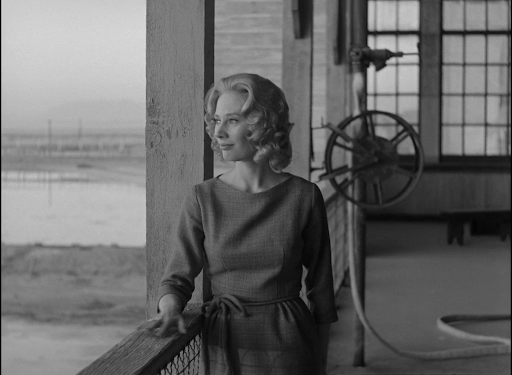A horror movie for the girls
If you haven’t heard of “Carnival of Souls,” I don’t blame you. It’s a low-budget independent B-horror movie–maybe even C-horror, depending on who you ask–from 1962 that I only know about because it was on a DVD collection of “Classic Horror” that I found at a thrift store. But today is your lucky day because this movie rules and I’m here to tell you all about it.
I don’t want to tell you too much about the plot because going in blind is the best way to watch this weird psychological thriller, but the story follows Mary Henry, a young woman who is the miraculous only survivor of a car wreck with two other girls. After convalescing, she leaves her Kansas hometown to take up a job in Salt Lake City as a church organist, wanting to escape the bad memories of the accident.
On her way to SLC, she passes a huge abandoned pavilion on the shores of Salt Lake. Her curiosity is piqued, but she heads straight to her destination. Then, of course, a bunch of weird stuff happens. She has visions of a ghastly dead man following her around–played by director Herk Harvey–and occasionally she becomes invisible to the rest of the world for no apparent reason. No one can hear or see her, and there is no rhyme or reason as to when it begins or ends.
From a weird, predatory male neighbor to a “Doctor Samuel” who isn’t a psychiatrist but tries to address Mary’s apparent psychological disturbance anyway, Mary goes through all of this without help until the end of the movie, where she finds herself dancing with the dead at the old pavilion, unable to escape.
While it sounds pretty cut-and-dry, the movie is a cult classic for a lot of reasons. The pacing and cinematography are disorienting and foreboding, with Harvey citing arthouse inspirations like Ingmar Bergman and Jean Cocteau. Harvey also made this movie with almost no money and no experience whatsoever. A maker of industrial and educational films, Harvey saw the real-life abandoned Saltair Pavilion on Salt Lake while driving one day and knew that he had to make a movie.
All he knew was that the end had to have a scene with a bunch of dead ballroom dancers in the pavilion, which he told writer and friend John Clifford. Clifford wrote the script in three weeks. It shows in a lot of ways, with somewhat stilted dialogue and amateur acting, but it works. The simplicity somehow makes the movie even more unsettling. Unfortunately, the Saltair has now been refurbished in a pretty bland way into a venue that’s still active, but this does mean you can still visit the location if you feel like making the drive to Utah. The movie flopped at the box office but later developed a cult following, which is probably how it made its way into my DVD collection.
This movie is weird, quiet, creepy, and filled with a terrifying and pervading sense of loneliness. Mary is experiencing something horrifying all alone with no one to help her or explain, and is also trying to maintain a normal life and career in a new town while this all happens.
“Carnival of Souls” is, to me, a very “girl” movie (as my roommate would again say). Having something terrible happen to you that no one else believes or can see and has male doctors calling you insane–well, it’s not too far off from the modern female experience. The way the movie is shot puts us in Mary’s place as she goes through this, and it’s scary as hell. This feeling that you are in mortal danger in broad daylight and only you know it–because you’re invisible to the world and being followed by a ghost who was already invisible to everyone but you–is familiar in a way.
It was actually really comforting to me in a weird way, to know that this all-consuming lonely fear was something other people could feel too–even if it’s a fictional ghost girl. There are way more in-depth, well-researched articles about this online that I encourage you to check out if you want, but “Carnival of Souls” is simultaneously a horror masterpiece and a fascinating proto-feminist commentary.
“Carnival of Souls” is clunky, reminiscent of the Twilight Zone, and a totally accidental masterpiece. Herk Harvey’s only feature film, directors like George Romero (“Night of the Living Dead”), David Lynch (“Twin Peaks, Lost Highway”), Leigh Whannell (“Saw,” “Insidious”) and M. Night Shymalan (“The Sixth Sense,” “The Village”) have all cited the film as a crucial inspiration.
If you take anything from the article, I want it to be just that you should watch this movie. It’s short, free to watch on the Internet Archive, and a genuine cinematic masterpiece. If you like thrillers or horror of any kind, check out “Carnival of Souls.“
